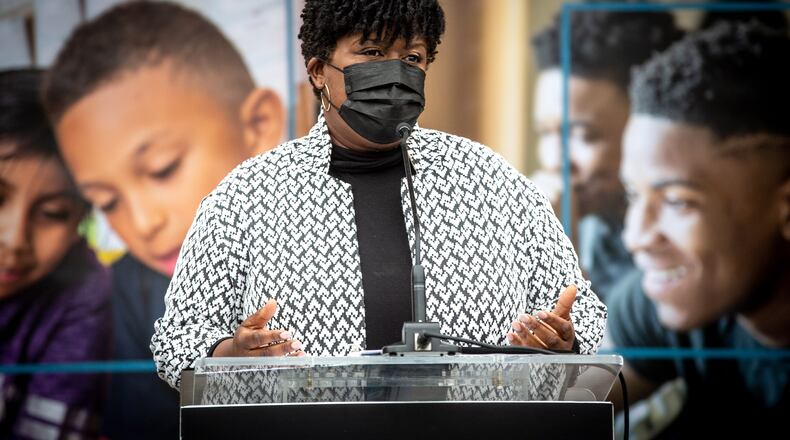Watch an Atlanta school board meeting or read the district’s strategic plan and one concern pops up again and again: Equity.
For years, Atlanta Public Schools’ students of color have trailed white students academically.
To correct that, the district did an equity audit. Officials wrote an equity policy. They formed an equity task force. In the fall, APS hired its first chief equity and social justice officer.
Now, the district is building an equity division with a staff of about three dozen, including six newly created positions. Equity, said Superintendent Lisa Herring, must “be at the forefront of all we do or it’s in the background.”
Herring, hired last year, is launching the Center for Equity and Social Justice during a pandemic that exposed deep divides in how equipped students are to learn online and following national protests demanding racial justice.
The new division is tasked with ensuring APS provides supports and services to help all students succeed. But skeptics remain wary it will bring needed change. They’ve heard district officials talk about equity for years and said they’ve seen little action.
”Where’s the plan and tell me how the plan equals equity?” said Shawnna Hayes-Tavares, a longtime parent advocate whose youngest child graduated from APS last year. “I’m happy that the equity process is here, but I don’t have any faith in Atlanta Public Schools that it’s going to be done with any kind of fidelity.”
The center will cost $1.9 million to run annually, about half of which represents a new expense to the district. The other half will be covered by grants and by reassigning existing positions. That total doesn’t include the district’s federal programs, which will be folded into the equity division.
Credit: Handout
Credit: Handout
Chief equity officer Tauheedah Baker-Jones will lead the effort and report directly to the superintendent. She said adding positions and creating a separate division is necessary because APS didn’t “have the infrastructure to do this work.” Previous equity efforts happened without a unified vision or strategy, she said.
Her first priority is to assess where APS needs to improve and what inequities exist. From there, her team will help develop programs and other initiatives to assist Atlanta’s historically underserved students. An equity scorecard will track student discipline and academic data in an attempt to hold APS accountable for its progress, or lack thereof.
Academic gaps
The district already knows that disparities exist among students, about three quarters of whom are Black. A majority of Atlanta students also live in poverty.
The four-year graduation rate for white students in the class of 2020 is 96.7%, almost 20 percentage points higher than their Black classmates.
By fourth grade, 76% of white students are performing on grade level, while only 23% of Hispanic students and 16% of Black students are meeting that same bar, according to APS.
At the current pace of progress, it would take 128 years to close the gap between Black and white students, said Baker-Jones. She suspects that chasm has only grown wider as a result of learning loss during the pandemic.
Some students didn’t have a computer, home internet access or an adult who could help them navigate virtual classes.
“When the pandemic hit, it just really broke away any illusions that things are OK,” said Dana Rickman, vice president of Georgia Partnership for Excellence in Education.
The nonprofit policy research organization listed equity as one of its top issues of 2021.
Rickman said nearly all school districts are talking about equity, though their commitment varies from “lip service” to “putting real money behind it.” She said APS’ approach could have real impact.
“Wherever you put the spotlight is what’s going to get the attention,” she said.
But she cautioned that school districts alone can’t fix inequities that stretch back centuries.
At APS, equity discussions gathered steam about a decade ago as the district tried to fix damage caused by a massive cheating scandal. With urging from advocates, the district paid for an equity audit.
It unearthed a host of problems. Some schools had no active parent-teacher groups. Students in one cluster of schools were far more likely to be suspended than those in schools in more affluent neighborhoods. Schools in wealthier areas also had more experienced teachers.
In the years since, the district overhauled how it funds schools with equity in mind and made other changes.
Byron Amos, an APS parent who served on the school board when the audit was done, said it identified a host of issues. Some of the district’s accomplishments since then, such as building playgrounds at schools that didn’t have them, felt like picking low-hanging fruit, he said.
After leaving the board, Amos was named to the district’s community equity task force, though he said the group hasn’t met in months. He supports the creation of an equity division and is hopeful the work will pick up momentum.
”That was a huge task to actually put money behind it,” Amos said.
Hayes-Tavares said she saw first hand the differences among schools her children attended. Some had orchestra, accelerated math and gifted programs. Others didn’t.
“We don’t need to keep talking about the disparities, we need to talk about the solutions,” she said.
In 2019, the Latino Association for Parents of Public Schools helped issue a report pointing out persistent academic gaps between Atlanta’s white students and students of color. Ricardo Miguel Martinez, the group’s president, said he’s “cautiously optimistic” about the district’s equity effort. He said teachers, students and parents must be included.
”All of those achievement gaps, failing schools, reading levels — all of those things — dictate the success of a Black and brown kid,” he said. “The expectation is that it has to work. It has to work. I think what we’re saying is, if we are not at the table this is not going to work.”
About Atlanta Public Schools
Enrollment: 51,000
Black students: 72%
White students: 16%
Hispanic: 8%
Two or more races: 3%
Asian: 1%
Low-income students: about 77%
Source: APS
About the Author
Keep Reading
The Latest
Featured




